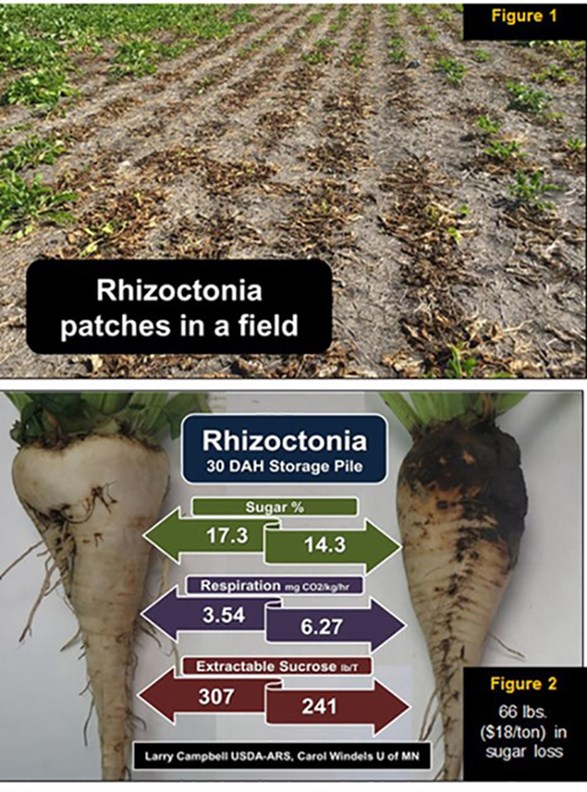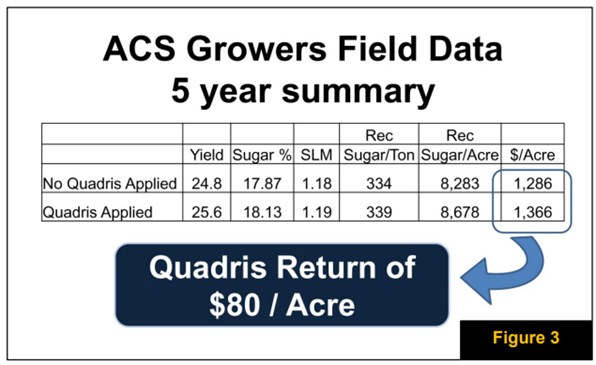598 - Rhizoctonia Management for Two Seasons
We have now entered a crucial time of the year at American Crystal Sugar Company, the sugarbeet production season. This is up to a 5½ month long endeavor requiring attention to detail for maximizing production in the field. A major detractor in sugarbeet production has been Rhizoctonia Crown and Root Rot (RCRR). Environmentally, Rhizoctonia (figure 1) thrives in wet, dry, or transitional soil moisture conditions. Introduce the pathogen and provide the sugarbeet as a susceptible host…the Disease Triangle is complete and you are on your way to losses in root yield, quality, profitability, and the losses don’t stop there. Enter the second season, the sugarbeet storage season which can last up to 8½ months. Disease damages incurred, Rhizoctonia being one of several, during the production season can persist into the storage season for a total effect of up to 14 months from planting through delivery of sugarbeets to the wet hopper. Sugarbeet storage respiration losses in the pile mount after delivery (figure 2) showing losses just 30 DAH (Days After Harvest) in conditions cooler than realized in storage piles. These losses can equate to 66 lbs. per ton sugar loss. Using a 3-year average NSP (Net Selling Price) per pound of sugar, results in $18 per ton in loss of recovered sugar from these infected roots.
Rhizoctonia Management Tips:
- Include small grains in your crop rotation
- Plant Rhizoctonia resistant/tolerant varieties
- Utilize fungicide seed treatments such as Kabina, Vibrance, or Metlock/Rizolex/Kabina for seedling protection lasting 4 – 5 weeks after planting
- Plant early and include starter fertilizer
- Utilize a POST application of Quadris (Figure 3) or Priaxor Fungicide 4 – 5 weeks after planting for up to an additional 8 weeks of protection
American Crystal Historical Replant Acreage
A look at our historic replants, overall low replant acreage in recent years, with some obvious tough spring conditions in past history. Many of you can recall those tough springs vividly. In case of replants, please refer to the Replanting Economics Decision Chart or contact your Agriculturist for further details:
| Crop Year | Replanted Acres | Replant Percent | Crop Year | Replanted Acres | Replant Percent |
| 1980 | 43,818 | 15.7% | 1998 | 7,210 | 1.4% |
| 1981 | 74,635 | 26.8% | 1999 | 8,472 | 1.7% |
| 1982 | 5,855 | 2.1% | 2000 | 4,837 | 1.0% |
| 1983 | 31,050 | 11.1% | 2001 | 1,240 | 0.3% |
| 1984 | 4,412 | 1.6% | 2002 | 80,022 | 15.4% |
| 1985 | 20,022 | 6.8% | 2003 | 3,026 | 0.6% |
| 1986 | 2,968 | 0.9% | 2004 | 22,088 | 4.4% |
| 1987 | 5,775 | 1.7% | 2005 | 6,225 | 1.2% |
| 1988 | 160,420 | 43.7% | 2006 | 1,594 | 0.3% |
| 1989 | 5,202 | 1.4% | 2007 | 10,354 | 2.1% |
| 1990 | 17,042 | 4.3% | 2008 | 12,462 | 3.0% |
| 1991 | 33,076 | 8.2% | 2009 | 364 | 0.1% |
| 1992 | 17,648 | 4.4% | 2010 | 1,833 | 0.4% |
| 1993 | 8,867 | 2.2% | 2011 | 1,693 | 0.4% |
| 1994 | 27,456 | 6.5% | 2012 | 13,206 | 3.0% |
| 1995 | 867 | 0.2% | 2013 | 446 | 0.1% |
| 1996 | 11,620 | 2.5% | 2014 | 148 | 0.0% |
| 1997 | 1,019 | 0.2% | 2015 | 8,441 | 2.1% |
The Importance of Seedling Development in the first 10 Weeks:
The following graphs (figure 4) demonstrate seedling multi-tasking and tendencies of growth and accumulation along with highlighting the importance of starting out the season with proper field production practices for maximizing plant development and crop production. Dr. Mitch McGrath, USDA-ARS, Sugarbeet Research Geneticist, Michigan State University and Paul Galewski, Michigan State University PhD Graduate Student along with other team members looked at various seedling development stages in the first 10 weeks after germination in greenhouse conditions. The study generated graphs illustrating well the many plant signals for early sugarbeet seedling development in terms of growth and moisture. Their project also noted: “A developmental transition appears around the 5-week mark, with a triggering event likely occurring prior to the time, and phenotypic effects occurring after this point.” Phenotypic effects refer to observation of plant growth in the environment grown. The Conical rings graph refers to the area in the root where sucrose is stored: “Sucrose is concentrated with the innermost five of 12-15 concentric cortical rings, around the point of maximum root girth. These features begin developing within five weeks after germination.” Thermal Hours refers to the temperature the seedlings were exposed in the greenhouse and duration.


We’ve Got Agronomy Apps for That
The American Crystal Sugar Agronomy App is available for further Rhizoctonia, Sugarbeet Root Maggot and Cercospora Leaf Spot DIV (Daily Infection Values) readings for your nearest NDAWN station.
